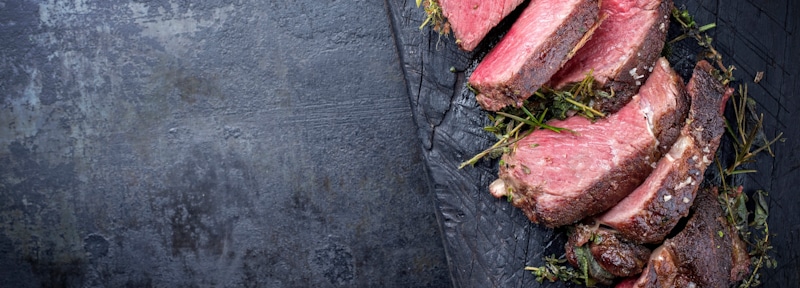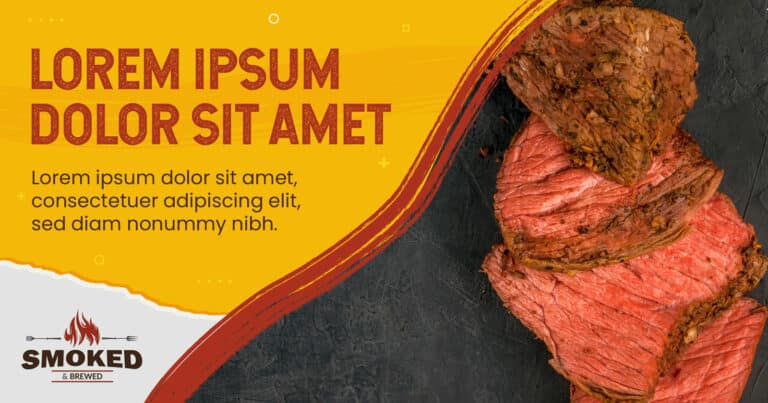Sous vide steak is the most reliable way to perfectly prepare a delicious steak every time you get into the kitchen.
With sous vide, you evenly cook your steak, ensuring that every edge is perfectly cooked. The first stage of sous vide steak includes sealing the steak in a plastic bag and letting it cook until it attains the desired level of doneness using the sous vide device. The second phase involves searing the steak to enhance its flavor, color, and texture rendering it tender and delicious.
Generally, sous vide provides you with the precision that you need to cook a delicious steak quickly. Whether you are a beginner or experienced sous vide expert, there is a lot that you need to learn.

How To Cook Sous Vide Steak
Cooking the sous vide steak is a simple process that anyone can easily accomplish without necessarily having a sous vide steak guide. The entire process involves two critical phases.
The first phase involves sealing the steak in a plastic bag before cooking it using the sous vide device. Cook the steak until it reaches your desired level of doneness.
The second phase entails searing the meat to create a textural contrast on the surface, enhance its flavor, develop color, and help it become tender and more delicious. You should carefully select the sous vide bath’s initial temperature because it influences your steak’s final doneness.
How To Select The Best Temperature For Your Sous Vide Steak
The temperature has a significant impact on the texture and the juiciness of the steak. If you do now want to lose most of the juice when cooking the steak, the rare-to-medium range will be the best option as it minimizes the juice loss and, at the same time, keeps fat inside the steak for more flavor.
Here is a breakdown of what you should expect at the different levels of doneness.
Rare Sous Vide Steak (120 degrees F)
Your steak is rare if its internal temperature is 120 degrees Fahrenheit. At this stage, the steak is still nearly raw. Since the muscle proteins are yet to contract much, touching the steak will give an impression of a slippery texture. Further, the steak will be chewier and tougher at this stage. The fat in the steak has hardly begun to render, hence a waxy texture. If you are not cooking very lean and tender steaks, avoid the rare level of doneness.
Medium Rare (129 Degrees F)
At this level of doneness, the steak looks nice and red. The muscle proteins have started to firm up, and some juices are getting lost. The good news is that even if your steak loses some juices, it is becoming tender. The medium rare is the best level of doneness for most steaks.
Medium Sous Vide Steak (135 degrees F)
At this level of doneness, the steak is a rosy pink and has lost a significant amount of juice. The texture of this steak is coarse. Even though the steak has lost a substantial amount of juices, the level of tenderness that it accumulates should compensate for the lost juices.
Well-done sous vide Steak (156 degrees F)
If you like your steak well done, then there is no need to employ the sous vide technique. Grilling your steak to a well-done level of doneness should serve you right.
The following is a chart for temperatures and the time you should cook your steak to achieve a different level of doneness.
| Doneness | Temperature Range | Timing Range |
| Very rare to rare | 120°F to 128°F | 1 to 2 1/2 hours |
| Medium-rare | 129°F to 134°F | 1 to 4 hours (2 1/2 hours max if under 130°F/54°C) |
| Medium | 135°F to 144°F | 1 to 4 hours |
| Medium-well | 145°F to 155°F | 1 to 3 1/2 hours |
| Well-done | 156°F and up | 1 to 3 hours |
Sous Vide Recipe
Preparing a delicious sous vide steak is a simple process. Even if it is your first time, you should get it right as long as you have all the necessary ingredients.
Ingredients
- Steak; strip, ribeye, porterhouse, T-bone steaks
- Salt and pepper
- Rosemary or sprigs of thyme
- Cloves garlic
- Oil
- Butter
Instructions
- Preheat the sous vide cooker until it reaches the desired final temperature. As the sous vide preheat, season your steak with pepper and salt and then put it in sous vide bags with herbs, shallots, and garlic and ensure that you distribute them evenly. Seal the bag and place it in the water bath for the preferred time and level of doneness according to the above chart.
2. Finish In A Pan
Get your steak out of the water and pat it dry with paper towels. Add vegetable oil to a heavy cast iron pan and place it on the source of fire until it starts to smoke.
3. Sear The Steak
Once the pan is hot enough, proceed to sear the steak. You can add a tablespoon of butter for a cleaner and more effective sear. Flip the steak after 15-30 seconds. Repeat the process until the steak develops a nice brown sear.
4. Serve The Steak
Get the steak out of the pan and transfer it to the serving board. Slice it against the grain of the meat and serve it immediately.
Which Type Of Steak Is Best To Cook Sous Vide
In addition to ensuring that you follow all the necessary directions, you must pick the right steak for the best results. Fortunately, there are several steaks that you can choose from, including the following.
1. Filet Mignon
The filet mignon is one of the best cuts for sous vide steak cuts. It is lean, healthy, and delicious. While it is a mouthwatering steak when prepared correctly, it is one of the most expensive cuts.
The best way to prepare the Filet Mignon steak is to cook it in the sous vide cooker for 2 hours at 127 degrees Fahrenheit. Cooking the steak at this temperature for this duration will make the steak juicy and delicious.
2. Ribeye Steak
Another excellent cut for sous vide steak is the Ribeye. The ribeye steak is quite popular among the BBQ enthusiasts. It is highly marbled with a rich fat content that gives it a loose grain of the meat.
Hence it is a tender cut. The Ribeye is a favorite cut for the sous vide steak for many people. An online sous vide steak guide may not provide you with this information.
3. Prime Rib Steak
The prime rib steak is a large roasting cut with more fat and connective tissues. With the high density of connective tissues and fats, you can be sure it is a flavorful cut. Since it is a tender cut, the sous vide cooking temperature should be about 131 degrees Fahrenheit.
4. Flank Steak
Although the flank steak is best known for preparing most fajitas recipes, it can make excellent sous vide steak. The sous vide technique makes the steak juicy and delicious. Also, due to the large size of the steak, it can make a perfect fit for a buffet table.
To sous vide the flank steak, set the temperature of the sous vide cooker at 132 degrees Fahrenheit. Cook it for 1.5 to 2.5 hours, depending on the thickness of the steak.

5. New York Strip Steak
The New York Strip Steak is known as Kansas City steak or shell steak. It is obtained from the short loin of a cow and comes from a less overworked area. Therefore, the steak is tender. For the best results, cook your New York Strip steak for 2-4 hours at 130 degrees Fahrenheit.
6. T-Bone Steak
The T-bone steak is the last cut on our list of the best sous vide steaks. It is packed with beef flavor, and its tenderness makes it easy for people to embrace different methods when preparing the steak. For a perfect sous vide meal, cook the steak at a temperature of 131 degrees Fahrenheit for 2 hours.
Conclusion
Sous vide cooking offers an opportunity to prepare juicy and delicious steak. It is a simple technique that involves sealing the steak in a plastic bag and cooking it in a hot water bath until it attains a specific temperature before completing the process through searing. With a sous vide steak guide, it takes less effort to prepare a mouthwatering dish.
Scot has loved smoking food in his free time for the last few years. Each major holiday or off-weekend, Scot spends days testing and prepping new recipes for perfection.

